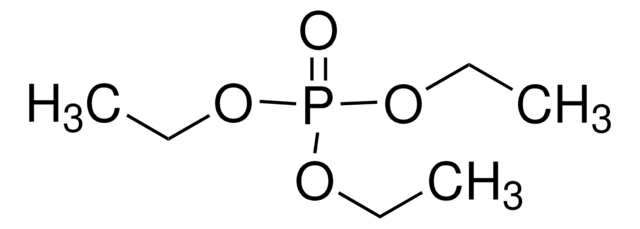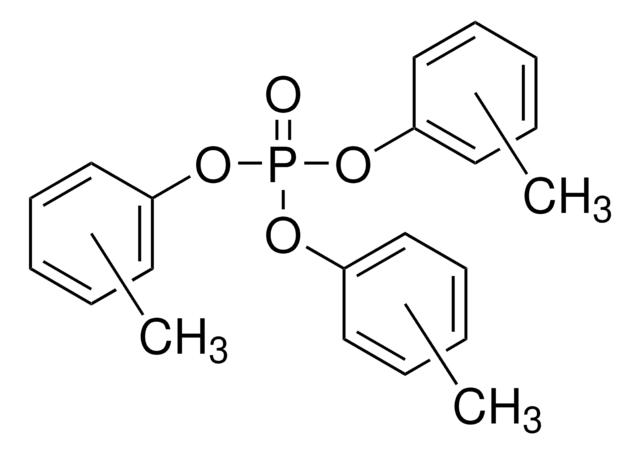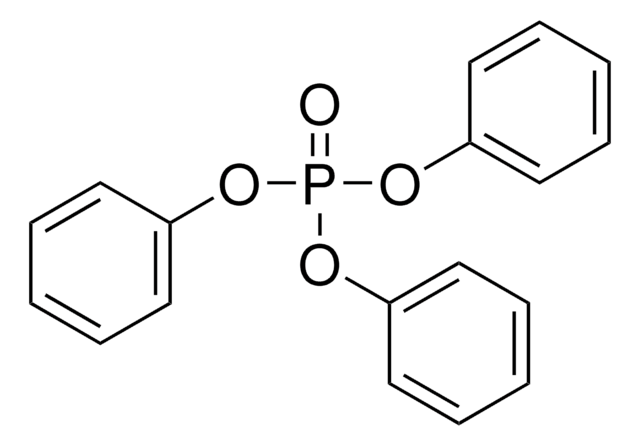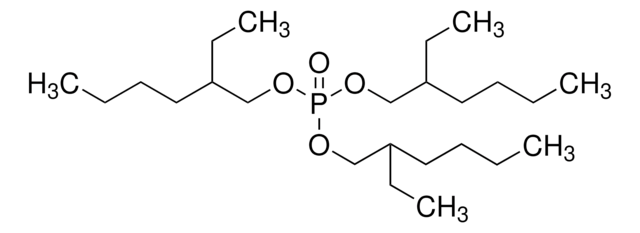Kluczowe dokumenty
51885
Tri-o-tolyl phosphate
analytical standard
Synonim(y):
NSC 438, Phosphoric acid tris(2-methylphenyl) ester, TOTP, Tri-o-cresyl phosphate
About This Item
Polecane produkty
klasa czystości
analytical standard
Poziom jakości
Próba
≥97.0% (HPLC)
okres trwałości
limited shelf life, expiry date on the label
zanieczyszczenia
≤0.5% water
współczynnik refrakcji
n20/D 1.559-1.563
Zastosowanie
environmental
Format
neat
temp. przechowywania
2-8°C
ciąg SMILES
O=P(OC1=C(C)C=CC=C1)(OC2=C(C)C=CC=C2)OC3=CC=CC=C3C
InChI
1S/C21H21O4P/c1-16-10-4-7-13-19(16)23-26(22,24-20-14-8-5-11-17(20)2)25-21-15-9-6-12-18(21)3/h4-15H,1-3H3
Klucz InChI
YSMRWXYRXBRSND-UHFFFAOYSA-N
Powiązane kategorie
Opis ogólny
Zastosowanie
- Analysis of tri-o-tolyl phosphate in edible oils by TLC and GC is described in methods FSSAI 02.036:2021 and FSSAI 02.037:2021
- Surface water and wastewater effluent samples by liquid chromatography coupled to tandem mass spectrometry equipped with electrospray ionization (LC-ESI-MS/MS) operating under the multiple reaction monitoring (MRM) mode of detection.
- Human hair and nails by liquid-liquid extraction (LLE) and gas chromatography-mass spectrometry (GC-MS).
- Indoor air, dust and window wipes by GC-MS/MS.
- Outdoor air samples by ultra-performance liquid chromatography coupled to triple quadrupole mass spectrometry (UPLC-QqQ-MS/MS) equipped with ESI source and MRM detection.
Polecane produkty
Hasło ostrzegawcze
Danger
Zwroty wskazujące rodzaj zagrożenia
Zwroty wskazujące środki ostrożności
Klasyfikacja zagrożeń
Acute Tox. 4 Oral - Aquatic Chronic 2 - STOT SE 1
Kod klasy składowania
6.1C - Combustible acute toxic Cat.3 / toxic compounds or compounds which causing chronic effects
Klasa zagrożenia wodnego (WGK)
WGK 3
Temperatura zapłonu (°F)
230.0 °F
Temperatura zapłonu (°C)
110 °C
Wybierz jedną z najnowszych wersji:
Certyfikaty analizy (CoA)
Nie widzisz odpowiedniej wersji?
Jeśli potrzebujesz konkretnej wersji, możesz wyszukać konkretny certyfikat według numeru partii lub serii.
Masz już ten produkt?
Dokumenty związane z niedawno zakupionymi produktami zostały zamieszczone w Bibliotece dokumentów.
Klienci oglądali również te produkty
Nasz zespół naukowców ma doświadczenie we wszystkich obszarach badań, w tym w naukach przyrodniczych, materiałoznawstwie, syntezie chemicznej, chromatografii, analityce i wielu innych dziedzinach.
Skontaktuj się z zespołem ds. pomocy technicznej












